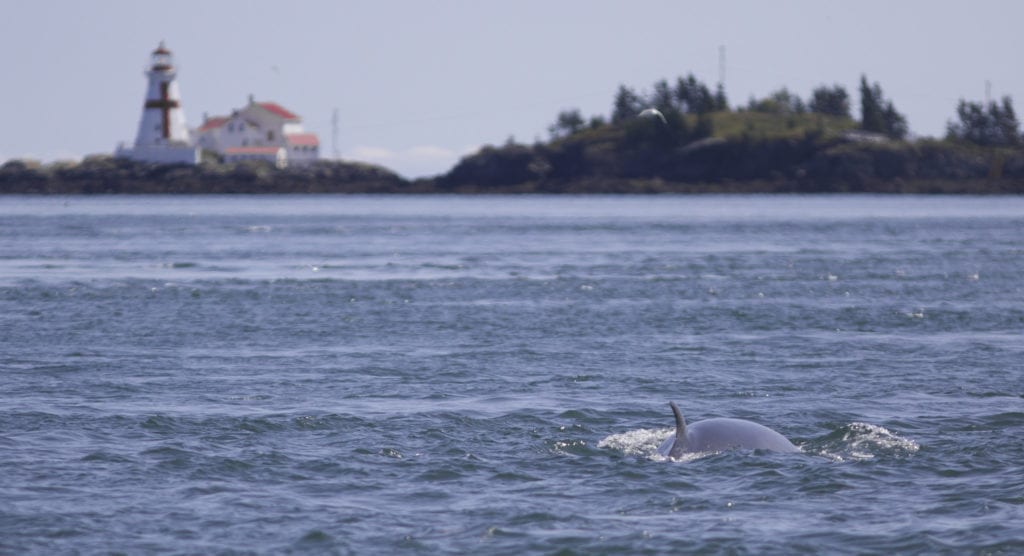
On 26 August, we ran our inaugural trip to explore the waters of Head Harbor Passage and it was awesome! The bottlenecked water from the extremely high tides off Eastport literally create a whirlpool, known as the Old Sow, where a variety of ‘bird food’ (especially krill) is brought to the surface and large numbers of gulls and other seabirds came to feed. In late August, this area is inundated with thousands of Bonaparte’s Gulls that have just finished breeding and come to take advantage of the abundance of food. Locally nesting Black-legged Kittiwakes join the frenzy and we challenge ourselves with the needle-in-a-haystack search for rare species like Little Gull.
As you can see from the map above, our route took us from Eastport through Head Harbor Passage and up to East Quoddy Head. We motored back along Deer Island and then explored Western Passage to trying building our ‘Maine list’ (since many of the species were seen in New Brunswick waters.)
Among the gulls, a number of species that nest on the relatively-nearby Machias Seal Island can be found in Head Harbor Passage after they leave the island. Above is a Razorbill chick that has been following its father since leaving its burrow.
And yes! We did find a Little Gull! These birds are much easier to spot when flying but we were able to pick an adult out of a roosting flock on Casco Bay Island (NB). As you can see above, the black underwing of the adult Little Gull really helps separate this species from the abundant Bonaparte’s Gull.
Species List:
Below is a complete list of species and an estimate of the total number of each species that were seen. This list and totals were generated using the eBird lists compiled during the trip and may include some double-counted birds (if the same birds were seen during two different segments of the trip).
Common Eider (Somateria mollissima) – 11
Surf Scoter (Melanitta perspicillata) – 1
Common Loon (Gavia immer) – 2
Great Shearwater (Ardenna gravis) – 33
Great Cormorant (Phalacrocorax carbo) – 10
Double-crested Cormorant (Phalacrocorax auritus) – 138
Great Blue Heron (Ardea herodias) – 1
Bald Eagle (Haliaeetus leucocephalus) – 5
Least Sandpiper (Calidris minutilla) – 1
Red-necked Phalarope (Phalaropus lobatus) – 12
Spotted Sandpiper (Actitis macularius) – 1
Razorbill (Alca torda) – 4
Black Guillemot (Cepphus grylle) – 11
Black-legged Kittiwake (Rissa tridactyla) – 71
Bonaparte’s Gull (Chroicocephalus philadelphia) – 2,091
Little Gull (Hydrocoloeus minutus) – 1
Herring Gull (Larus argentatus) – 645
Great Black-backed Gull (Larus marinus) – 218
Black Tern (Chlidonias niger) – 3
Arctic Tern (Sterna paradisaea) – 105
American Crow (Corvus brachyrhynchos) – 9
eBird:
eBird users can add the segmented checklists to their accounts by clicking on the “Add to my eBird” links below. ONLY click on the red links if you were on this trip, otherwise you can still view the lists using the blue “view” links.
Maine Audubon-Head Harbor Passage 2017–Segment I – View – Add to my eBird
Maine Audubon-Head Harbor Passage 2017–Segment II – View – Add to my eBird
Maine Audubon-Head Harbor Passage 2017–Segment III – View – Add to my eBird
Maine Audubon-Head Harbor Passage 2017–Segment IV – View – Add to my eBird
Maine Audubon-Head Harbor Passage 2017–Segment V – View – Add to my eBird
Thanks!
Many thanks to everyone who joined us on this inaugural trip! We look forward to running this again next year and continuing to explore the diverse areas and species that Maine (and our nearby waters) have to offer.

